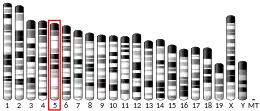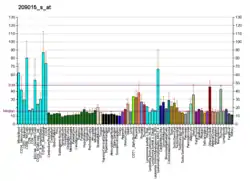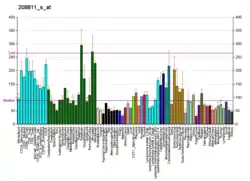DnaJ homolog subfamily B member 6 is a protein that in humans is encoded by the DNAJB6 gene.[5][6][7]
Function
This gene encodes a member of the DNAJ protein family. DNAJ family members are characterized by a highly conserved amino acid stretch called the 'J-domain' and function as one of the two major classes of molecular chaperones involved in a wide range of cellular events, such as protein folding and oligomeric protein complex assembly. This family member may also play a role in polyglutamine aggregation in specific neurons. Alternative splicing of this gene results in multiple transcript variants; however, not all variants have been fully described.[7]
Interactions
DNAJB6 has been shown to interact with keratin 18.[8] It has been also shown that the aggregation of Aβ42 (a process involved in e.g. Alzheimer's disease) is retarded by DNAJB6 in a concentration-dependent manner, extending to very low sub-stoichiometric molar ratios of chaperone to peptide.[9] Dominant mutations in DNAJB6 have also been found to cause a late-onset muscle disease termed limb-girdle muscular dystrophy type D1 (LGMDD1), which is characterized by protein aggregation and vacuolar myopathology.[10]
References
- 1 2 3 GRCh38: Ensembl release 89: ENSG00000105993 - Ensembl, May 2017
- 1 2 3 GRCm38: Ensembl release 89: ENSMUSG00000029131 - Ensembl, May 2017
- ↑ "Human PubMed Reference:". National Center for Biotechnology Information, U.S. National Library of Medicine.
- ↑ "Mouse PubMed Reference:". National Center for Biotechnology Information, U.S. National Library of Medicine.
- ↑ Seki N, Hattori A, Hayashi A, Kozuma S, Miyajima N, Saito T (June 1999). "Cloning, tissue expression, and chromosomal assignment of human MRJ gene for a member of the DNAJ protein family". Journal of Human Genetics. 44 (3): 185–9. doi:10.1007/s100380050139. PMID 10319584.
- ↑ Pei L (January 1999). "Pituitary tumor-transforming gene protein associates with ribosomal protein S10 and a novel human homologue of DnaJ in testicular cells". The Journal of Biological Chemistry. 274 (5): 3151–8. doi:10.1074/jbc.274.5.3151. PMID 9915854.
- 1 2 "Entrez Gene: DNAJB6 DnaJ (Hsp40) homolog, subfamily B, member 6".
- ↑ Izawa I, Nishizawa M, Ohtakara K, Ohtsuka K, Inada H, Inagaki M (November 2000). "Identification of Mrj, a DnaJ/Hsp40 family protein, as a keratin 8/18 filament regulatory protein". The Journal of Biological Chemistry. 275 (44): 34521–7. doi:10.1074/jbc.M003492200. PMID 10954706.
- ↑ Månsson C, Arosio P, Hussein R, Kampinga HH, Hashem RM, Boelens WC, et al. (November 2014). "Interaction of the molecular chaperone DNAJB6 with growing amyloid-beta 42 (Aβ42) aggregates leads to sub-stoichiometric inhibition of amyloid formation". The Journal of Biological Chemistry. 289 (45): 31066–76. doi:10.1074/jbc.M114.595124. PMC 4223311. PMID 25217638.
- ↑ Bengoechea R, Findlay AR, Bhadra AK, Shao H, Stein KC, Pittman SK, et al. (August 2020). "Inhibition of DNAJ-HSP70 interaction improves strength in muscular dystrophy". The Journal of Clinical Investigation. 130 (8): 4470–4485. doi:10.1172/JCI136167. PMC 7410071. PMID 32427588.
Further reading
- Maruyama K, Sugano S (January 1994). "Oligo-capping: a simple method to replace the cap structure of eukaryotic mRNAs with oligoribonucleotides". Gene. 138 (1–2): 171–4. doi:10.1016/0378-1119(94)90802-8. PMID 8125298.
- Suzuki Y, Yoshitomo-Nakagawa K, Maruyama K, Suyama A, Sugano S (October 1997). "Construction and characterization of a full length-enriched and a 5'-end-enriched cDNA library". Gene. 200 (1–2): 149–56. doi:10.1016/S0378-1119(97)00411-3. PMID 9373149.
{{cite journal}}: CS1 maint: overridden setting (link) - Izawa I, Nishizawa M, Ohtakara K, Ohtsuka K, Inada H, Inagaki M (November 2000). "Identification of Mrj, a DnaJ/Hsp40 family protein, as a keratin 8/18 filament regulatory protein". The Journal of Biological Chemistry. 275 (44): 34521–7. doi:10.1074/jbc.M003492200. PMID 10954706.
{{cite journal}}: CS1 maint: overridden setting (link) - Hartley JL, Temple GF, Brasch MA (November 2000). "DNA cloning using in vitro site-specific recombination". Genome Research. 10 (11): 1788–95. doi:10.1101/gr.143000. PMC 310948. PMID 11076863.
- Ohtsuka K, Hata M (April 2000). "Mammalian HSP40/DNAJ homologs: cloning of novel cDNAs and a proposal for their classification and nomenclature". Cell Stress & Chaperones. 5 (2): 98–112. PMC 312896. PMID 11147971.
- Wiemann S, Weil B, Wellenreuther R, Gassenhuber J, Glassl S, Ansorge W, et al. (March 2001). "Toward a catalog of human genes and proteins: sequencing and analysis of 500 novel complete protein coding human cDNAs". Genome Research. 11 (3): 422–35. doi:10.1101/gr.GR1547R. PMC 311072. PMID 11230166.
{{cite journal}}: CS1 maint: overridden setting (link) - Chuang JZ, Zhou H, Zhu M, Li SH, Li XJ, Sung CH (May 2002). "Characterization of a brain-enriched chaperone, MRJ, that inhibits Huntingtin aggregation and toxicity independently". The Journal of Biological Chemistry. 277 (22): 19831–8. doi:10.1074/jbc.M109613200. PMID 11896048.
{{cite journal}}: CS1 maint: overridden setting (link) - Farinha CM, Nogueira P, Mendes F, Penque D, Amaral MD (September 2002). "The human DnaJ homologue (Hdj)-1/heat-shock protein (Hsp) 40 co-chaperone is required for the in vivo stabilization of the cystic fibrosis transmembrane conductance regulator by Hsp70". The Biochemical Journal. 366 (Pt 3): 797–806. doi:10.1042/BJ20011717. PMC 1222832. PMID 12069690.
{{cite journal}}: CS1 maint: overridden setting (link) - Hanai R, Mashima K (September 2003). "Characterization of two isoforms of a human DnaJ homologue, HSJ2". Molecular Biology Reports. 30 (3): 149–53. doi:10.1023/A:1024916223616. PMID 12974469. S2CID 24105834.
- Liu Y, Zhu MC, Wang YJ, Zhan Z, Liu CG (November 2003). "[Cloning of a DnaJ homolog chaperon PBP and its subcellular localization]". Xi Bao Yu Fen Zi Mian Yi Xue Za Zhi = Chinese Journal of Cellular and Molecular Immunology. 19 (6): 531–4. PMID 15182641.
{{cite journal}}: CS1 maint: overridden setting (link) - Berruti G, Martegani E (January 2005). "The deubiquitinating enzyme mUBPy interacts with the sperm-specific molecular chaperone MSJ-1: the relation with the proteasome, acrosome, and centrosome in mouse male germ cells". Biology of Reproduction. 72 (1): 14–21. doi:10.1095/biolreprod.104.030866. PMID 15342353.
- Wiemann S, Arlt D, Huber W, Wellenreuther R, Schleeger S, Mehrle A, et al. (October 2004). "From ORFeome to biology: a functional genomics pipeline". Genome Research. 14 (10B): 2136–44. doi:10.1101/gr.2576704. PMC 528930. PMID 15489336.
{{cite journal}}: CS1 maint: overridden setting (link) - Rual JF, Venkatesan K, Hao T, Hirozane-Kishikawa T, Dricot A, Li N, et al. (October 2005). "Towards a proteome-scale map of the human protein-protein interaction network". Nature. 437 (7062): 1173–8. Bibcode:2005Natur.437.1173R. doi:10.1038/nature04209. PMID 16189514. S2CID 4427026.
{{cite journal}}: CS1 maint: overridden setting (link) - Dai YS, Xu J, Molkentin JD (November 2005). "The DnaJ-related factor Mrj interacts with nuclear factor of activated T cells c3 and mediates transcriptional repression through class II histone deacetylase recruitment". Molecular and Cellular Biology. 25 (22): 9936–48. doi:10.1128/MCB.25.22.9936-9948.2005. PMC 1280278. PMID 16260608.
- Linse S, Thalberg K, Knowles TP (2021). "The unhappy chaperone". QRB Discovery. Cambridge University Press. 2: e7. doi:10.1017/qrd.2021.5. PMC 10392682. PMID 37529680.
External links
- DNAJB6 human gene location in the UCSC Genome Browser.
- DNAJB6 human gene details in the UCSC Genome Browser.





